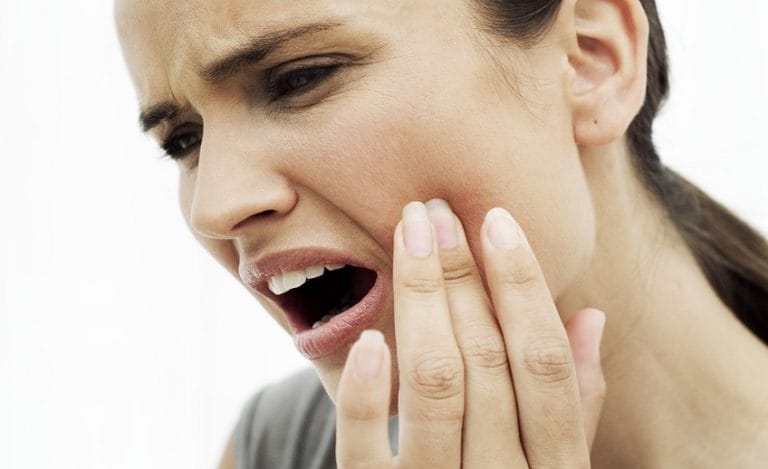Have you noticed a sore on your mouth, and you don’t know what to do? There are many kinds of mouth sores. Some are painful and unsightly but harmless. Others seem benign but can lead to complications. Regardless of how it looks or feels, make a dental appointment with our Port Washington dental team if it is still there after 10 days or if you think it could be an infection. Serious complications can often be prevented if you act early.
What Are The Most Common Mouth Sores and Infections?
Burning Mouth Syndrome
Just as the name indicates, people with this condition feel oral burning sensations without any apparent lesions or blisters. Sufferers describe the feeling as similar to scalding from drinking a hot beverage.
Signs, Symptoms and Diagnosis
Areas affected include:
- the tongue
- the back of the throat
- the palette
- the gums
- inside the cheeks
Diagnosis of this condition is a process of elimination. Blood tests, cultures, biopsies and a complete health history can be used to help pinpoint your condition.
Causes of Burning Mouth Syndrome
The causes are unknown, but this syndrome has been linked to certain conditions.
- diabetes
- menopause
- malnutrition
- oral thrush
- nervous system disorders
According to the American Dental Association, this condition has even been linked to some cancer therapies and psychological disorders.
Treatment of Burning Mouth Syndrome
Because the exact cause is unknown, comfort measures are prescribed based on managing the related conditions. There are some things you can try at home.
- Stop using mouthwash for two weeks to see if your symptoms improve.
- Don’t chew gum, as this may be causing irritation.
- Don’t smoke.
- Stay away from acidic drinks like sodas, coffee and fruit juice.
- Change your toothpaste, making sure to use an ADA-approved brand.
Prevention of Burning Mouth Syndrome
Although the cause is unknown, preventive measures include avoiding triggers that make your condition worse.
Candidiasis
Signs, Symptoms and Diagnosis
Also called “thrush”, Candidiasis is a fungal infection. If you get Candidiasis, you may experience:
- white spots on the tongue or other oral surfaces
- cracked skin at the corners of your mouth
- a sore throat and problems swallowing
Candidiasis is a common infection. Your doctor or dentist will most likely diagnose you by the appearance of your mouth and your description of what you are feeling.
Causes of Candidiasis
Oral thrush is caused by an overabundance of yeast in the mouth or throat. This natural part of our body’s flora can grow out of control in people who wear dentures, those with a compromised immune system and people who suffer from dry mouth. Antibiotics also trigger oral thrush.
Treatment of of Candidiasis
It is treated with antifungal medications and medicated mouthwash. In addition, excellent oral hygiene is an important tool for keeping Candida at bay. If you wear dentures, make sure to clean them well and remove them at night.
Prevention of Candidiasis
Prevention is focused on good oral hygiene. Follow the suggestions above. If you have dry mouth, ask your dentist for prescription solutions that mimic natural saliva.
Canker sores
Signs, Symptoms and Diagnosis
These are shallow, round, painful lesions with red borders that can show up on the inside of the cheeks or lips, on your tongue or on your gums. They can appear one at a time, or you can have up to 10 or more at once.
If you get canker sores frequently, your doctor can run some blood tests to diagnose blood, skin or connective tissue disorders. You may also be tested for drug reactions.
Causes of Canker Sores
Their cause is unknown, but scientists suspect they are related to an immune disorder. They take 2-3 days to form, and usually go away after 2 weeks.
The larger ones can last longer and leave scars.
Treatment of Canker Sores
- Specialized mouthwashes can reduce the pain.
- Over-the-counter gels and creams help numb the area for pain relief.
Prevention of Canker Sores
Because the specific causes are unknown, prevention involves monitoring what seems to trigger your outbreaks and staying away from those triggers. To keep the cankers from worsening, try these steps.
- Refrain from eating spicy, scalding or acidic foods. These can irritate the tissues even more.
- Ask your dentist if antibiotics may help
- Ask about oral bandages so that you can prevent secondary infections.
Following these suggestions can alleviate your symptoms and shorten their duration.
Cold Sores and Fever Blisters
Signs, Symptoms and Diagnosis
These are small, contagious blisters filled with fluid that break out around the lips, nose or chin. You may also experience:
- burning, tingling or itching lips
- oozing and crusting after the blisters burst
Usually your dentist can diagnose these lesions by their appearance. They may swab the sores and send the swab to a lab for confirmation of the diagnosis.
Causes of Cold Sores and Fever Blisters
They are caused by the herpes simplex virus type 1 (HSV-1). Once a person is infected (usually in childhood), the virus remains in the body. It stays mainly dormant with occasional outbreaks.
When to See a Dentist About Cold Sores and Fever Blisters
If you are concerned about infection, consult with your dentist right away. Other signs that you should make a dental appointment include:
- the lesions last more than 2 weeks
- you have severe symptoms
- the recurrences are frequent
- your eyes are also irritated
Your dentist will evaluate you to determine the best therapeutic options.
Treatment of Cold Sores and Fever Blisters
Cold sores and fever blisters most often heal on their own within a week. Try these treatments to heal faster and minimize the frequency of outbreaks.
- Cold compresses help speed healing, and reduce the associated crust and redness.
- Over-the-counter pain creams can help with the discomfort. Look for creams that contain benzocaine or lidocaine, as these medications help numb the skin
- Lip balms and creams containing zinc oxide help keep your lips moisturized and minimize cracking.
- The Mayo Clinic recommends over-the-counter cold sore remedies that help dry out the lesions with alcohol.
In addition to the milder treatment options above, you may also get an antiviral prescription from the dentist to control the outbreaks and heal faster.
Antiviral medications you might get from your dental office include acyclovir, valacyclovir and famciclovir. These all target the herpes simplex virus.
Prevention of of Cold Sores and Fever Blisters
The Mayo Clinic reports that HSV-1 spreads through skin-to-skin contact, even if lesions are not visible. Because of this, prevention is difficult. Antiviral medications will not prevent contracting HSV-1, but they can reduce the frequency of outbreaks.
Sialadenitis
Signs, Symptoms and Diagnosis
People with this condition have one or more salivary glands that have suddenly become hard and painfully swollen. You may experience pain when eating or notice drainage from the salivary gland.
Your primary care doctor or dentist might order an ultrasound, CT (computed tomography) scan or MRI (magnetic resonance imaging) to diagnose this condition. A biopsy (tissue sample) may be taken as well.
Causes of Sialadenitis
One cause of acute sialadenitis is bacteria (most often Staphylococcus aureus) that blocks the opening of a salivary gland, causing infection. The infection can become systemic and cause flu-like symptoms. Other possible causes include:
- mumps
- HIV (human immunodeficiency virus)
- tumors that can be benign or malignant
- obstruction by a stone or duct narrowing
According to 2014 research published in the American Family Physician, some people are predisposed to getting this condition:
- diabetics
- people with hypothyroidism
- people in renal (kidney) failure
- people taking medications to treat allergies, urinary incontinence or Parkinson’s disease
Make sure your doctor knows your health history and the medications you take so they can offer the best treatment options.
Treatment of Sialadenitis
Your dentist may prescribe antibiotics for this condition. Other therapies include:
- massaging the salivary glands
- staying well-hydrated
- sucking on lozenges that stimulate salivation (called sialagogues), like vitamin C lozenges or lemon drops
- surgical removal of tumors, whether benign or malignant
Prevention of of Sialadenitis
The wide variety of causes makes prevention of this condition difficult. Taking care of underlying conditions and using the treatment methods listed above can reduce the frequency of occurrences.
Conclusion
The bottom line is that mouth tissue disorders and related conditions are common. The pain they can cause and their often unsightly appearance can make you want to hide away from other people.
But don’t lose hope!
The good news is that there are ways to combat them.
- Work closely with your denstist
- Maintain good dental hygiene
- Educate yourself about the causes, prevention and treatment
Arming yourself in this way can help you prevent infection, keep related conditions at bay and treat them when they appear.
If you have questions about your oral health or mouth sores specifically, contact our dental team today for your consultation.



